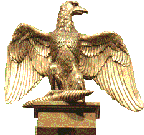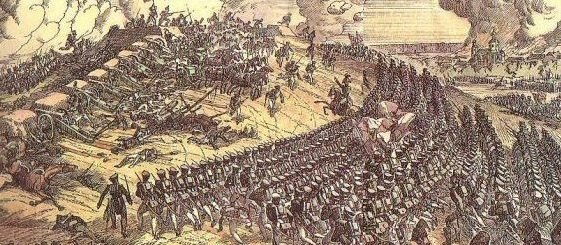
The Battle of Borodino, 1812.
"Of all my 50 battles, the most terrible was
the one I fought at Moscow (Borodino)"
- Napoleon



Battle of Shevardino (5 Sept), and Battle of Borodino (7 Sept).
While pursuing the Russian rear guard Napoleon's advance guard came at Shevardino.
It was the left flank of the Russian army deployed behind Kolocha River to prevent
the French from advancing along the Smolensk road to Moscow.
Davout's and Murat's troops attacked the Russian rear guard at Shevardino.
Poniatowski drove the Russians out of Yelnia and joined Davout and Murat.
After a ferocious fight, the French captured the redoubt.
On Sep 7th the Battle of Borodino begun.
|

Napoleon's Invasion of Russia, 1812
Causes of War
'The Second Polish War'
'The Great Patriotic War'
Napoleon on the Niemen River.
|
|

French Army and Commanders at Borodino.
At Borodino Napoleon had 84.500 infantry in 203 battalions, 21.500 cavalry in 230 squadrons and 16.000 gunners and engineers with 500-550 guns. Total of approx. 120.000 men. There were many nationalities in Napoleon's army. See diagram below.
Davout and I Corps
DAVOUT'S TROOPS:
-------------------------------------------------------------------
Ney and III Corps
NEY'S TROOPS:
Eugene and IV Corps
EUGENE'S TROOPS:
Murat and Reserve Cavalry
NANSOUTY'S I CAVALRY CORPS:
MONTBRUN'S II CAVALRY CORPS:
GROUCHY'S III CAVALRY CORPS:
LATOUR-MAUBOURG'S IV CAVALRY CORPS:
Other Troops
|
|

Russian Army and Commanders at Borodino.
De Tolly and his First Western Army
[NOTE: On average the Russian infantry division had 4 jager and 8 infantry battalions and
12-36 guns.
At Borodino some divisions had their jagers detached and posted in the woods or along the
river. See map below.]
RIGHT WING: GoI MILORADOVICH
LEFT WING: GoI DOHTUROV
RESERVES
-------------------------------------------------------------------
Bagration and his Second Western Army
III Infantry Corps: GL Tuchkov-I
|
|

Deployment of Troops.
Kutuzov ordered Bagration to defend the southern part of the front. Here were built several v-shaped field fortifications known as the 'Bagration Fleches'. The fourth earthwork was slightly to the north, by Semonovskaia village. The village of Semenovskaia being of totally wooden construction it had been dismantled and burned to provide a clear field of fire. North of Bagration Fleches was Raievski Redoubt (ext.link), also called Great Redoubt (or Death Redoubt). Tolstoy descrided it: "... on to the high knoll on which militiamen were at work excavating. This was the redoubt, as yet unnamed, afterwards called Raievski's redoubt, or the battery on the mound." and "The redoubt consisted of a mound, with trenches dug out on three sides of it. In the entrenchments stood ten cannons, firing through the gaps left in the earthworks. In a line with the redoubt on both sides stood cannons." In front of Bagration Fleches stood the Shevardino Redoubt. It was erected to provide early warning of French advance from that direction. During battle of Borodino here was Napoleon's headquarter.
The Battlefield.
Napoleon.
Kutuzov.
|
|

The Battle.
"Before dawn on 7 Sept the bands on the right flank began playing the reveillle to wake up the infantry, and it was gradually picked up all
along the line. They pleyed the most rousing pieces. Music does a great deal to prepare the
spirit for battle. ...
As soon as it was light, a short imperial proclamation was read out to each battalion. Soon after, the cannon opened fire on the left flank ..."
(Chlapowski, - p 116)
The artillery barrage signalled the attack of infantry. In the center part of Davout's infantry (5th Division) moved against the fleches, on the northern flank part of Eugene's corps attacked Borodino.
Southern Flank. |
|

Six Attacks on 'Bagration Fleches'
Davout's First Attack on Fleches.
Cavalry Charges.
Second and Third Attack on Fleches.
Cavalry Charges.
Fourth, Fifth and Sixth Attack on Fleches.
The 4 hours of savage fighting against Davout's and Ney's infantry took a heavy
toll on the Russians. Approx. 350 French guns inflicted horrible casualties on the defenders.
|
|

Fight For the Raievski Redoubt.
First Attack on Raievski Redoubt.
Second Attack on Raievski Redoubt. Captain Francois of 30th Line Regiment described one of the attacks on Raievski Redoubt: "Nothing could stop us... We hopped over the roundshots as it bounded through the grass. Whole files and half-platoons fell, leaving great gaps. General Bonamy ... made us halt in a hail of canister shot in order to rally us, and we then went forward at the pas de charge" A line of Russian troops tried to halt us, but we delivered a regimental volley at 30 paces and walked over them. We then hurled ourselves at the redoubt and climbed in by the embrasureds; I myself got in through an embrasure just after its cannon had fired. The Russian gunners tried to beat us back with ramrods and levering spikes. We fought hand-to-hand with them, and they were formidable adversaries."
|
|

Saxons' Charge.
Latour-Maubourg's IV Cavalry Corps moved in two columns:
(Saxony had three regiments of cuirassiers, all held Guard status. At Borodino were two: Garde du Corps and Zastrow.
Uniform of Garde du Corps: brass helmet with fur turban and crest, white plume, black leather peak edged brass.
Brass chin scales. Tunic was pale buff, faced blue, with orange piping around the top of the collar, down the front
of the tunic, and on the turnbacks. Officers: gold epaulettes, gold belts and gold ciphers and edging to shabraque.
Trumpeters: red tunic, white breeches and silver trumpet with gold cords. - Howard Giles)
In 1812 the Saxon Garde du Corps and Zastrow had much smaller, though sturdy horses, either black or very dark-brown, supplied
by dealers as Mecklenburgers.
|
|

Poniatowski on the Flank.
The Poles pushed the Russian skirmishers out of the wood and at 10:30 a.m. Poniatowski moved his artillery forward. More than 20 guns deployed and directed their fire on the Russians in and around Utitza. Kutusov learned about Poniatowski's advance against his flank and ordered Baggovout's II Infantry Corps to march south to assist Tuchkov. Baggovout left 12 jager battalions along the Kolocha River and with the remaining forces moved south.
The rapid advance of the Poles forced the Russian artillery to withdraw. Then the Poles were met by the Russians
and a bloody fight began. Tuchkov's grenadiers and Baggovout's infantrymen pushed the attackers back
as far as the village of Utitza.
(The Pavlovsk Grenadier Regeiment wore old-fashioned mitre-caps until the end of Napoleonic Wars.
In 1807 for their gallant fight at Friedland Tzar Alexander ordered that, alone of the
infantry, this regiment should henceforth retain its mitres "in the state in which they left the battlefield as visible mark
of its bravery and Our grace.")
|
|

Breakthrough.
Napoleon was unsure of the situation on the smoke-obscured battlefield. "He sat very still most of the time, showing little emotion, even when listening to the reports of panting officers who, without dismounting, retailed news from the front line. He would dismiss them without a word, and then go back to surveying the battlefield through his telescope. He had a glass of punch at 10 am, but brusquely refused all offers of food. He seemed very absorbed ..." (Zamoyski - "Moscow 1812" pp 271-272)
Artillery Fire Created Havoc.
|
|

Cossacks' Raid.
Kutuzov probably expected more, Platov and Uvarov were the only top commanders
which were not submitted by Kutuzov to awards for Borodino. Britten-Austin writes "Ouvarov was severely reprimanded
for making such a mess of his diversion. It was only years afterwards that he and his fellow Russian generals realized that he had
saved Russia from the disaster which would have overtaken its army had Napoleon, in his usual manner, thrown in
the Imperial Guard through the hole that, between 11 and 1 o'clock, had been blasted in the Russian
centre. Only the Prussians' timely arrival at Waterloo would save Wellington from exactly the same
catastrophe." (Britten-Austin - "1812 The March on Moscow" p 381)
|
|

Grand Cavalry Charge
Barclay de Tolly had deployed Tolstoy's IV Infantry Corps (8-12 battalions) to the left of the redoubt with its left wing pulled back (facing Friant's division in Semonovskaia village). Behind Tolstoy's troops was placed Raievski's battered VII Infantry Corps (8-12 battalions) and 6 Guard battalions. De Tolly began forming third line as a reserve with II & III Cavalry Corps and 8 Guard squadrons. (Korf's II Cavalry Corps hadn't arrived by the time the French final assault began, and III Cavalry Corps had majority of squadrons engaged around Bagration Fleches.)
The Capture of Death Redoubt.
Large Cavalry Battle.
|
|

The End of Battle.
Napoleon retained some 20,000-30.000 fresh troops (Imperial Guard, the Vistula Legion and I Cavalry Corps) but the remaining forces were exhausted physically and mentally. The French spent the day after the battle tending wounded and resting. Napoleon was in a state of extreme depression. Napoleon and his marshals were amazed at the stubborness of the Russians and feared the prospect of meeting them again. On Septemner 8th Murat began pursuit but soon was stopped by the Russian cavalry near Mozhaisk.
Casualties at Borodino.
March on Moscow.
|
|
The second Polish War has begun.
- Napoléon's Bulletin to La Grande Armée, |

Sources and Links.